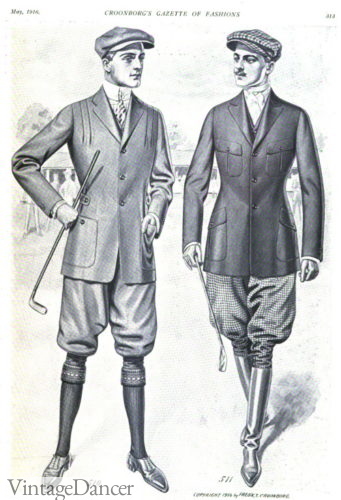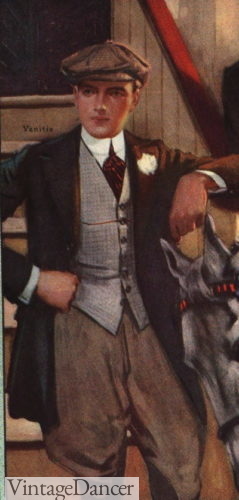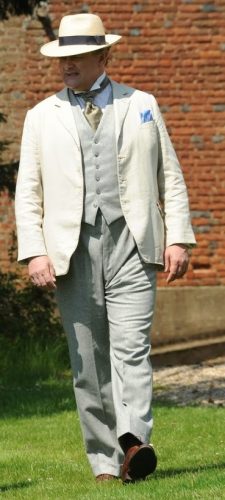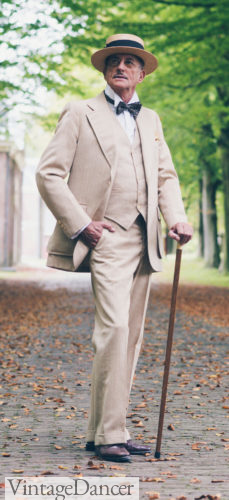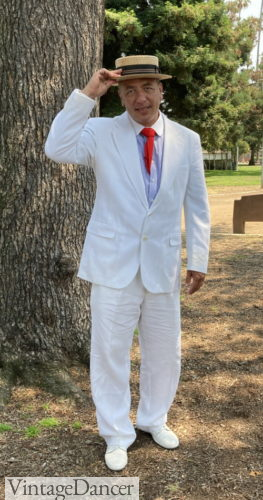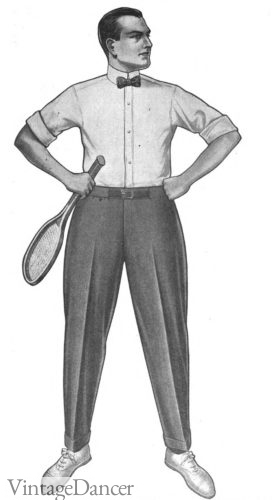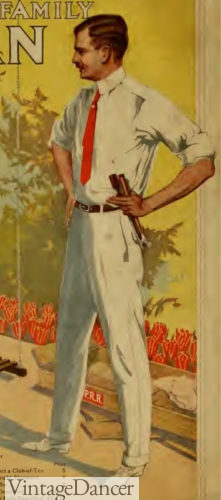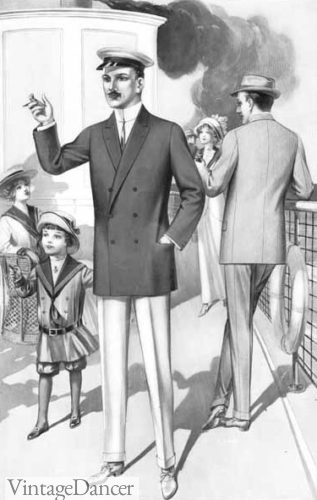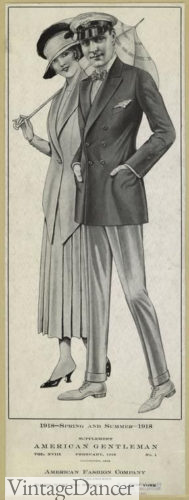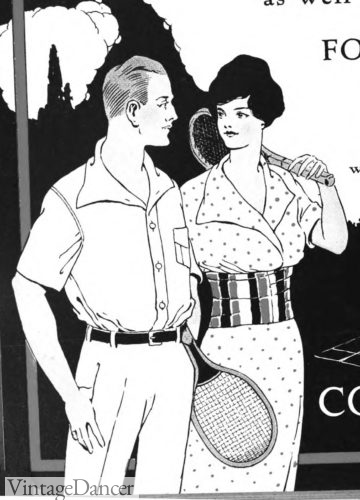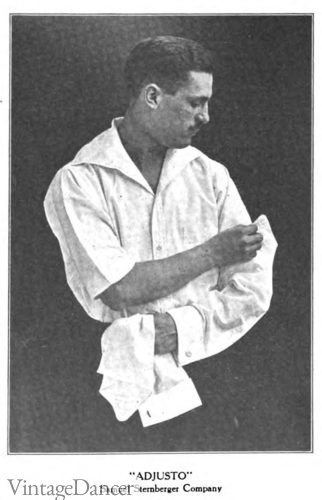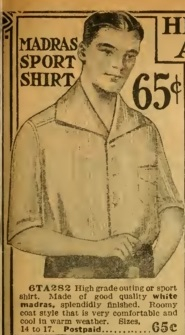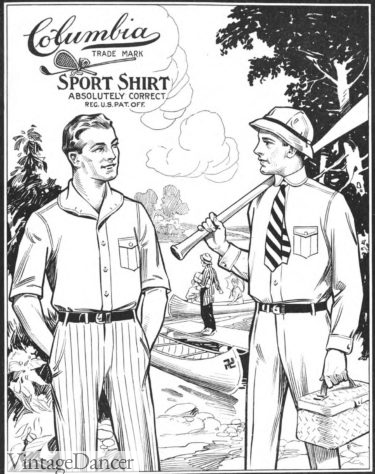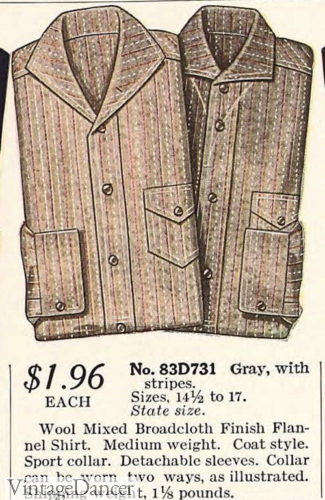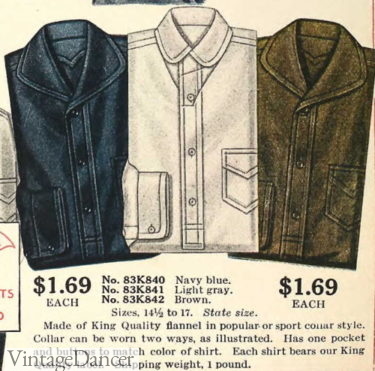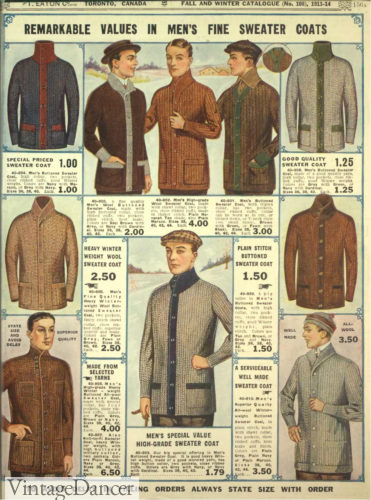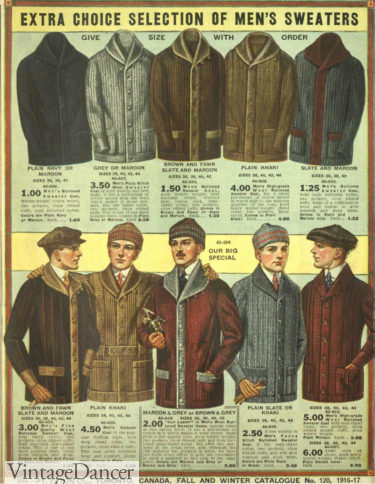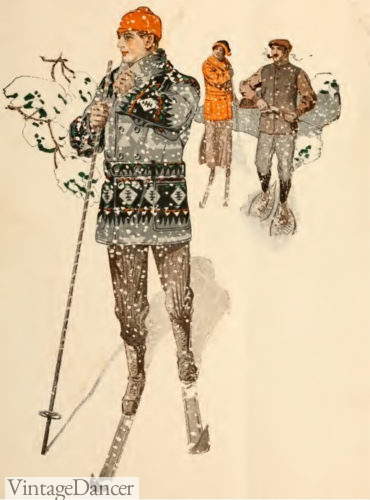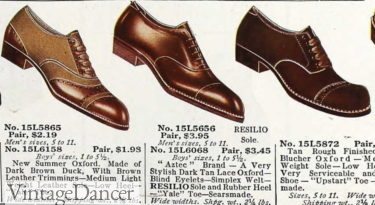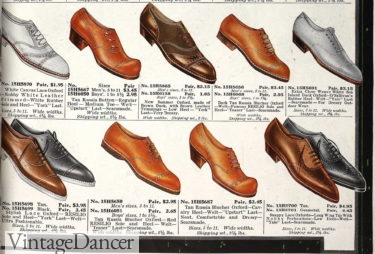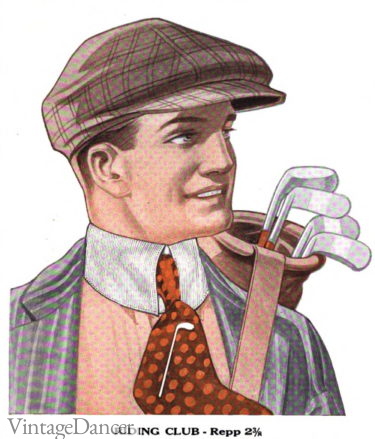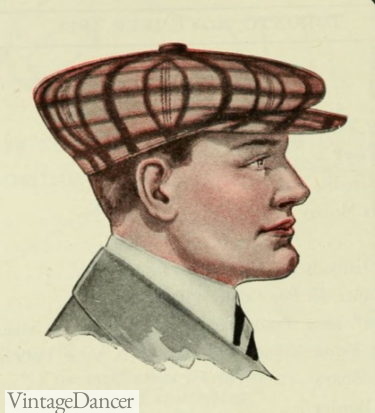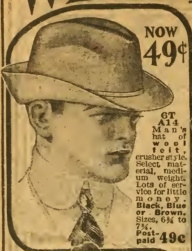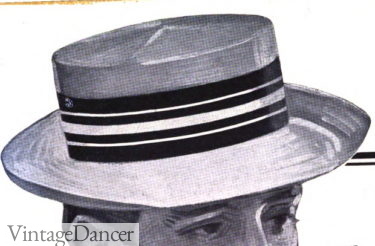Casual men’s clothing during the 1910s was hardly what we think of as casual today. Men wore suits at all hours of the day for all occasions, even the poor. Most sports included wearing some form of suit or suit separates paired with knitwear in cool weather, or in white for summer activities.
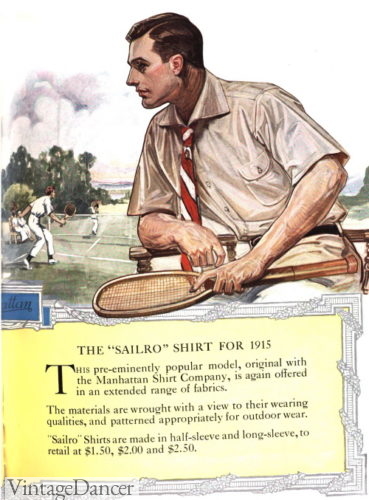
1914 short sleeve Sport shirt for a game of Tennis
Most upper-class casual attire was borrowed from the lower classes, who in turn did their best to mimic upper-class formality. Men’s fashion during the Edwardian era was gradually moving towards a more relaxed or casual style, especially after WWI. It wasn’t anywhere near where it would be by the 1930s, but it was, in the latter half of the 1910s, the beginning for new styles of suits, casual shirts, colorful sweaters, and two-tone shoes.
This article explores upper and middle-class men’s casual clothing from 1910 to 1920. You can also read about men’s business clothes suits and working-class clothing here.
Men’s Country Suits
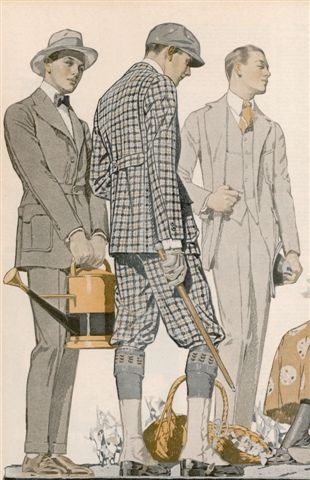
Tweed and windowpane Norfolk suits
London was the men’s fashion capital, even for Americans. Though Americans had little notion of what “country dress” was, they favored the sportier, more casual styles for watching and playing sports. The Norfolk suit was inspired by the hunting jacket worn by the Duke of Norfolk in the early eighteenth century. It had two box pleats down each side in front and back, ending at a flapped patch pocket. The belted back or all around belt models were very popular and are highly collectible today. The Norfolk was first advertised in 1911 as a golf suit but was worn for bicycling, croquet, and horseback riding as well.
It was advertised as “a thoroughly serviceable suit for men who are young, either in years or in spirit, and who wish to be distinctly well dressed, even on their own outings.”
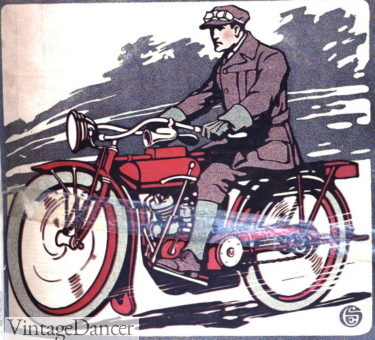
1914 Norfolk suit for motorcycle riding
The Norfolk jacket was paired with knickers buckled below the knee, heavy wool knee socks, and a tweed cap. It could also be worn with long trousers made of Harris or Donegal tweed. In summer, fashionable men paired the Norfolk jacket (or a standard suit jacket) with white linen or flannel trousers and straw skimmer/boater hat. The combination created the first “sports jacket” attire.
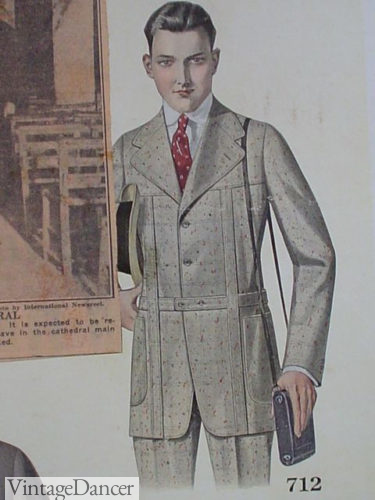
1916 men’s tweed Norfolk suit
Norfolk jackets and almost any color of spare pant could be combined into a casual yet sophisticated look. Adding colorful accessories was a way to spin this British country look into an American dandy. A brown jacket with taupe pants, brown socks, brown and white Oxford shoes, pink silk shirt, and green bow tie was seen at one resort in 1919. It stood out from the sea of drabness.
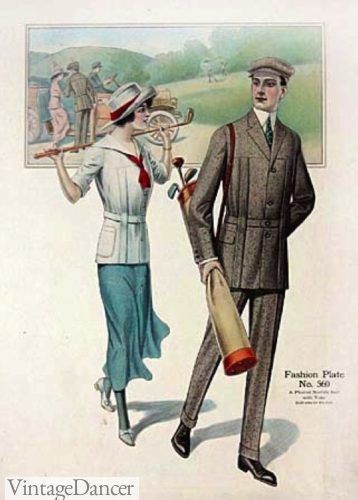
Full belt Norfolk suit
Other country suits were the Sunningdale and Suffolk. The latter had two box pleats down the front with patch pockets, but only one center box pleat in the back. Some had side vents and others did not. The Sunningdale had a series of pleats running vertically from the top of the back down about 2.5 inches. The pleating was repeated at the waist. These pleats made the jacket roomy for swinging a golf club. Americans wore them for their comfort factor, even if they never set foot on a golf course.
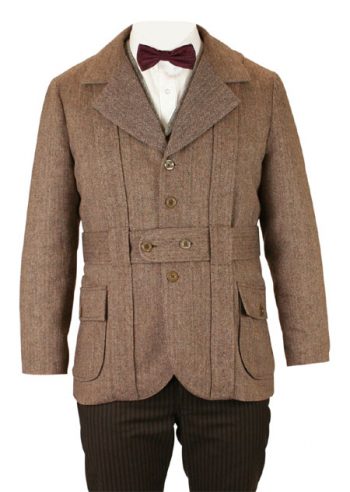
Repro Norfolk Jacket
Sports coats not styled after the Norfolk were worn in summer. They were shaped like a suit jacket, but often had two to four large patch pockets and one or two button closure. Some took styles note from Safari jackets and came in Khaki cloth.
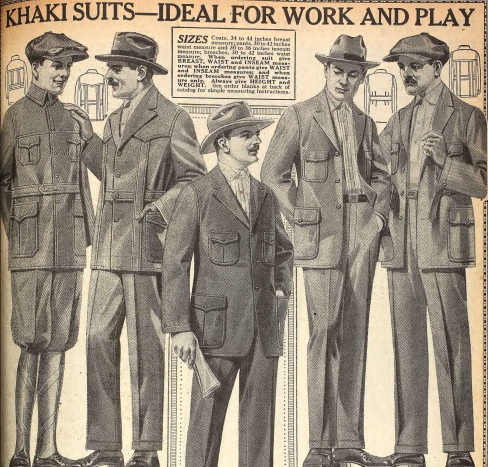
1918 khaki suits for work or play
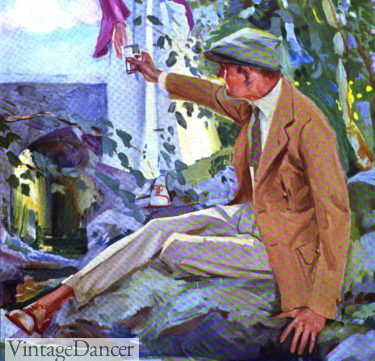
1918 casual summer outing set
Casual suits were sold without vests and in lighter tropical weight wools. Below, on the left, a man wears a Madras sports shirt with sports coat, trousers, and belt. On the right, the man wears a single link button sports coat with three patch pockets and a silk scarf.
Shop men’s suits and sport coats.
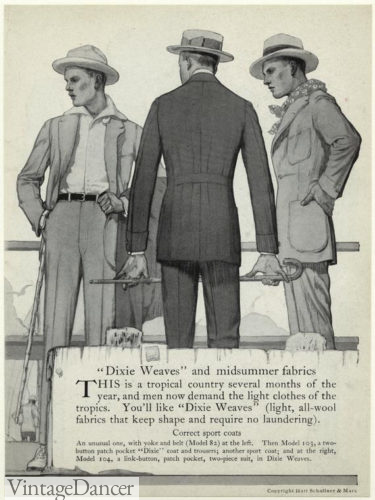
1918 summer sport coats/suits
Casual Knickers and Pants
Boys often wore short pants or bloomers, while men wore knickers with sporty outfits. The difference between men’s and boys short pants was insignificant. Men’s knickers were like those of trousers, but a bit baggier in the thigh with a buckled cuff just below the knee. The pants hung over the knee in a balloon-like fashion. Men’s sports knickers were always paired with tall knit socks, called hose, and short Oxford shoes.
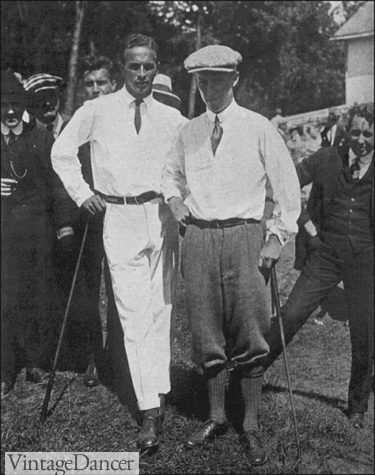
Men golf sport knickers: Chick Evans (right) just after winning the 1916 US Amateur Championship at the Merion Golf Club. On the left is Robert A. Gardner the defending champion who Evans beat in the finals
Similar riding breeches or winter hunting pants such as Mackinaw breeches had lace-up cuffs or ribbed knit cuffs. They fit close to the leg so that tall boots could be worn over them.
- 1916 riding outfits
- 1914 riding outfit
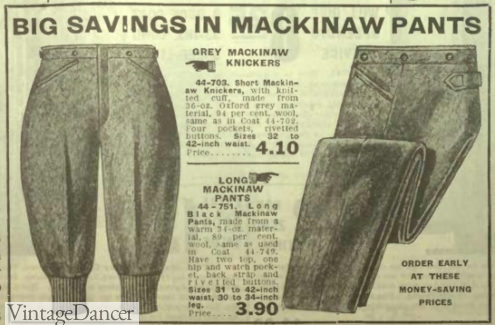
1918 Mackinaw hunting knickers and pants
Playing and watching sports was usually an upper-class activity. You would not see lower and middle classes wearing knickers. Instead, they wore casual long pants in the same shape as suit trousers but with more variety of materials. Wool serge, tweed, corduroy, duck cloth, worsted cotton, whipcord, serge, flannel, linen, and moleskin were the main fabrics. Primary colors were brown, grey, or navy. Summer introduced khaki, tan, ivory, and white.
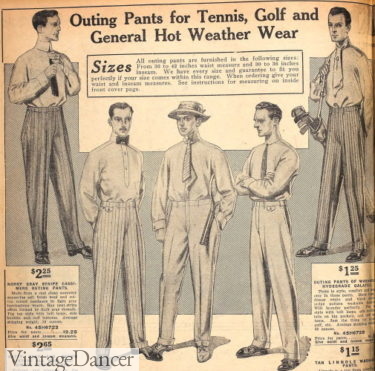
1912 men’s casual pants- stripes, khaki or white
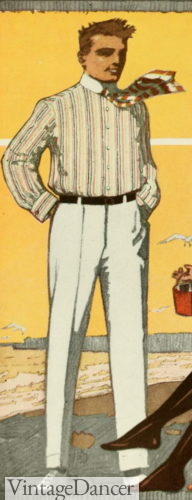
1918 white duck cloth trousers
Many wool fabrics had chalk stripes, a light colored vertical striping, in the material. Stripes added a hint of color and excitement to an otherwise unnoticeable garment. Young men embraced bold stripes, check, herringbone, plaid, and windowpane fabrics. As the decade wore on, the variety of textures and colors expanded quickly. These were sewn into informal weekday suits but mostly as weekend lounge suits and separates.
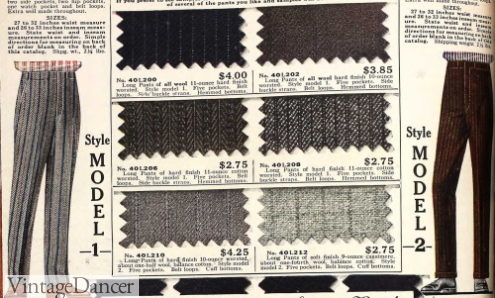
1918 trousers fabrics
Men’s pants were usually held up by button-on suspenders made of striped cotton webbing. However, belts were available in the later years and were preferred by men wearing casual attire. The belted pant look with a plain Oxford shirt looked cleaner and better fitting than when wearing suspenders. Pants were sold with button-on suspenders or with belt loops, but not both. Some pants were designed for neither, leaving it to the man to get the fit of his trousers snug enough for them to stay up.
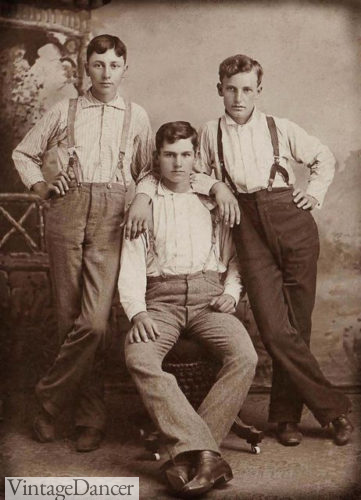
Young men wearing trousers, shirts, and suspenders

1918 men’s tan leather belt
Summer Whites
In summer, men’s 1910s suits and trousers lightened up with colors to match the season. Light blue, green, grey, tan, ivory, and white dominated upper-class summer wardrobes. These light colors were worn during leisurely pursuits such as vacationing to a beach or seaside resort, picnicking, taking a cruise, yachting, or playing summer sports such as golf, tennis, cricket, and polo.
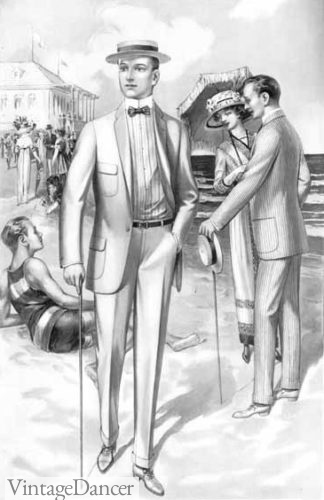
1912 white one button coat beach suit
Wearing white was an especially high-class fashion because it meant they could afford having servants to clean them. White beach cloth or Palm Beach fabric was the latest and greatest material to come over from India. Breathable, light, and usually white, it was perfect for tropical climates and hot summers at the beach. Palm beach suits were usually paired with pants, however some long shorts were spotted at high-end resorts in 1918. A coordinating vest was worn in the city, but avoided in the country or when on vacation.
Read more about white suits and sailing /boating outfits.
- 1918 Lord Grantham is his summer whites (white jacket over grey trousers and vest)
- Ivory suit inspired by the Edwardian male summer fashion
- Oscar’s White Summer Suit, 1910s
The jacket could be removed, revealing a soft white or striped Oxford or sport shirt with the sleeves rolled up and a belt, colorful tie or bow tie, white socks, and white suede or leather Oxford shoes. This was the ultimate summer casual style for men.
- 1914 tennis outfit- white shirt, casual pants, white tennis shoes
- 1915 white summer outfit
Not all summer outfits were white on white. The yachting outfit consisted of a six-button navy blue double-breasted jacket over white trousers and topped with a yachting cap. Shop summer suits and yachting jackets.
- 1912 yacht outfit with captains cap
- 1918 yacht outfit
Casual Shirts
Men’s casual shirts married the color of dress shirts with the style of work shirts. Men’s pajamas shirts, called Neglige shirts, were pullover with a long button down plaquette and attached matching cuffs. Like dress shirts, they were striped: white ground with blue or black stripes, or a blue ground with white stripes.
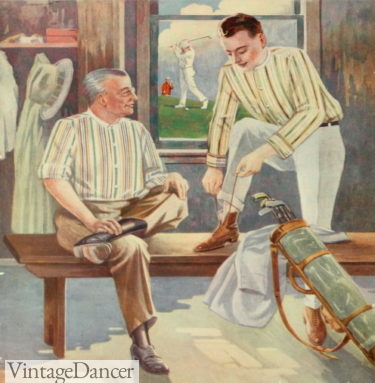
1918 striped collarless shirts for sportswear
They were made of silk-like fabrics to give them a rich appearance, even though they were only appropriate to wear for sports and leisure activities outside of the home. Most were sold collarless, with the option to attach a soft white collar or matching colored collar. Shop men’s shirts.
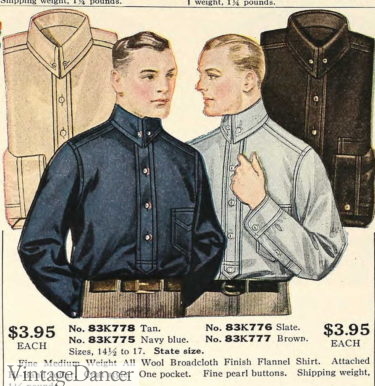
1917 men’s flannel sport or work shirts
Men’s ties were usually worn with most casual suits and sport/golf outfits. The bow tie was a popular and fun option, as well as skinny silk or knit tie ties in solid or stripes. Regular ties with a four in hand knot were also an option. Colors were mainly jewel tones in popular patterns such as thin stripes, paisley, polka dots, and some very funky swirls that seem almost modern art or at least Art Deco inspired. See pictures of ties here.
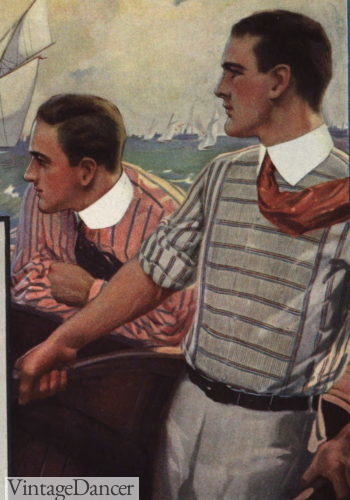
1914 men’s casual shirts and ties
The white madras sports shirt was the only true casual shirt, outside of the neglige or flannel work shirt. It was short sleeved, loose, button-down shirt with a wide open fold-down sailor collar and a single chest pocket. The madras material was similar to muslin cotton with a light open weave, developed in India to be comfortable in the hot and humid climate. It came in other light cotton fabrics as well as well as long sleeves.
Learn more about men’s 1910s shirt styles.
- 1914 short sleeve sport shirt
- 1914 short sleeve sport shirt with detachable long sleeve
- 1915 madras sport shirt
- 1915 short or long sleeve sport shirts
- 1915 long sleeve sport shirts
- 1917 long sleeve sport collar shirts
Men’s Sweaters
Khaki knit pullover sweaters were a uniform staple during the war. Many women knit them for their loved ones and shipped them off to the fronts. Although returning men were anxious to never wear khaki again, they were thankful for the comfort and warmth a knit sweater provided.

US Army knit sweaters
The sweater became a replacement for stiff jackets. In fact, they were called sweater coats (button down cardigan style), cardigan jackets, or knit coat (pullover style). Some were designed after the Norfolk jacket and were worn for any sport or leisure activity where a Norfolk suit was normally worn.
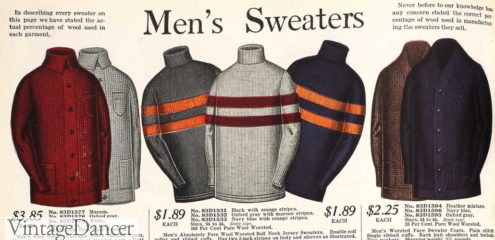
1915 knitwear sweaters-jackets, roll neck jerseys, cardigans
For civilians, color was added to previously drab monotone sweater coats (cardigans). Both pullovers with large round collars and sweater coats with a shawl or big round collar came in rich colors- navy blue, grey, olive, brown, maroon, and two-tone stripes or contrasting trim. Young men replaced stiff jackets on the golf course with pullover sweaters, and skiiers took to wearing brightly colored sweaters and blanket cloth coats on the slopes. With these changes, knitwear moved from purely utilitarian underwear to fashionable clothing.
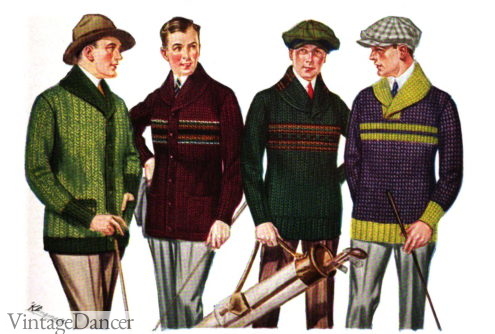
1918 men’s sport sweaters and cardigans
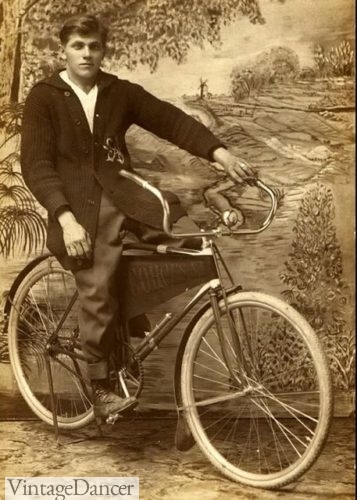
1915 a monogrammed sweater for this biker
Shop men’s Edwardian style sweaters. Learn more about men’s sweater and knitwear history.
- 1913 mens sweaters and cardigans
- 1916 mens shawl collar sweaters and cardigans
- 1915 ski outfit
In spring and summer, many sports turned to using knit sweaters and sleeveless sweater vests as part of a sport’s uniform. At school, these featured team or school colors (e.g. light blue for Cambridge, navy for Oxford) or a big school letter appliqued on the front. Below, a game of cricket at Downton Abbey had everyone dressed in ivory sweater vests, some trimmed in school colors. Shop men’s sweater and sweater vests.
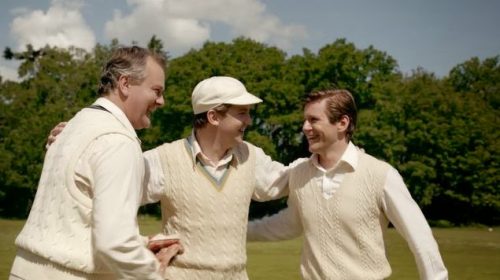
Knit sweater vests for a Cricket game at Downton Abbey
Casual Sport shoes
Despite the introduction of more sport clothing, there was little new to the shoe market. Most men wore Oxford shoes, not boots, with casual suits and sport clothes. White or brown leather or suede Oxfords with rubber soles were the most common in summer.
Some two-tone Oxfords combined leather and duck cloth (brown and white / brown and tan / black and grey) were seen on wealthy golf courses but had yet to go mainstream. Learn more about men’s 1910s shoes.
Shop men’s Edwardian era style shoes.
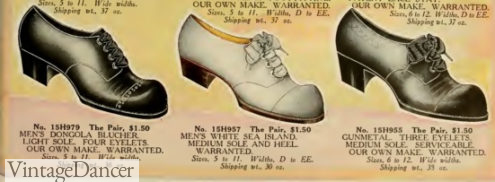
1912 summer oxford shoes
- 1918 summer oxfords- duck cloth and leather
- 1917 canvas, leather, two tone sport shoes
The summer sandal had yet to be invented although there were ventilated oxfords with cut outs in the body.
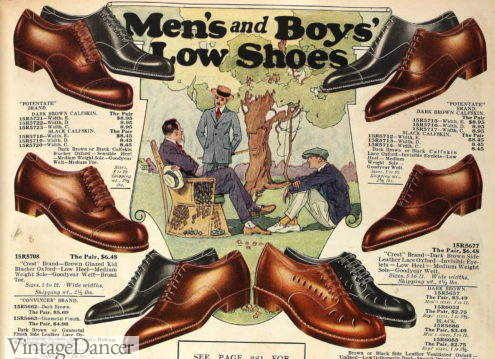
1919 men’s oxford shoes for all seasons and ventilated “sandals”
In 1915, the Converse shoe company started to make rubber sole shoes with canvas or leather tops for the athletic market. They were especially prized for indoor sports like basketball but also outdoor court sports such as Tennis.
By 1920, boys and young men were wearing Converse (and knock off brands) sport shoes for indoor and outdoor casual sports.

1915 canvas sport shoes
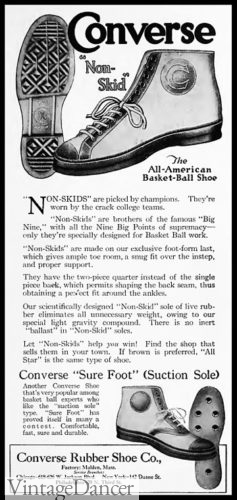
1920s Converse
Men’s Summer Hats
The final piece of a man’s casual wardrobe was his hat. The cap made of wool in winter or cotton/wool/linen in summer was the ideal casual hat. While they could be plain most were made with big and bold patterns – plaid, checks, stripes- and they hardly ever matched suits. A man’s cap called attention to his state of casualness. Whereas his suit might look formal, his cap spoke to his schedule for the day.
- 1915 plaid cap
- 1918 check cap hat
In summer, the straw hat provided a more dressy alternative to the sporty cap. The round, flat brimmed boater or sailor straw hat with the solid band often sported a man’s school or club color.
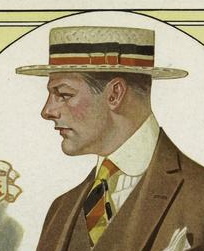
1910 Short Boater Hat
The straw Neglige hat was a similar casual hat, ideal for driving in the country, with a flat round crown and a rolled brim in the back or both sides. The flat top round telescope hat has ideal for young men.
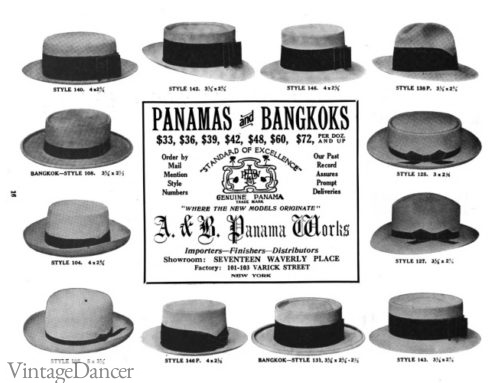
1914 Straw hats
The Optimo Panama hat was too dressy to be considered casual, yet it could be worn with white summer suits. Fedora hats could also be worn with dressy summer suits or sporty Norfolk suits.
- 1915 Crusher Fedora
- 1910 telescope straw hat
Finally, cloth hats in the shape of the fedora or floppy bucket hat were economical and cool to wear for hot sports like tennis.

1913 casual hats : The suburban straw hat, Neglige straw hat, Mexican straw hat, and cotton tennis hat.
Learn more about men’s 1910s hat styles.
Edwardian men’s Casual Outfit Ideas
For Motoring, Driving, Country: Norfolk jacket (or tweed suit jacket), matching vest, tweed knickers or long pants, tweed cap, fedora or Panama straw hat, soft collar shirt, necktie, cloth or soft leather gloves, and oxford shoes or lace up boots. Tall sox or leather gaiters for low shoes.
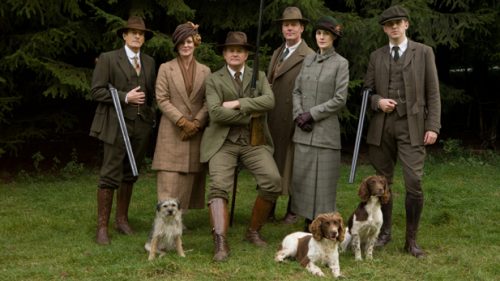
Downton Abbey out for a hunt in the country
Golf, tennis, cricket, rowing: White flannel trousers or tweed knickers, white or striped soft collar shirt, cable knit sweater vest, skinny knit tie or bow tie, cap or straw boater hat.
Cruise attire: All white, ivory or grey summer suit or navy blue yachting jacket, white pants, straw hat or yacht cap, leather belt, bow tie, walking cane, white Oxford shoes.
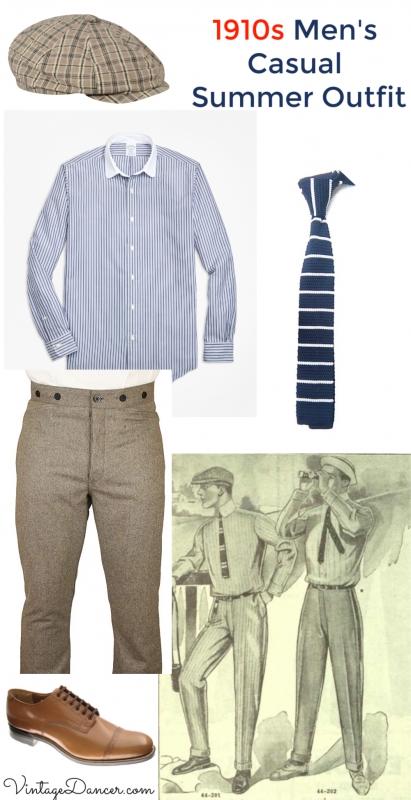
How to dress in casual summer outfit
An easy summer 1910s casual outfit idea – hat, shirt, tie, pants, shoes.
Lower class casual: Trousers, stripe soft collar shirt, suspenders, lace up boots and a cap. See 1910s working class clothing.
Middle class: add a knit tie, wear a belt instead of suspenders, and oxford shoes.
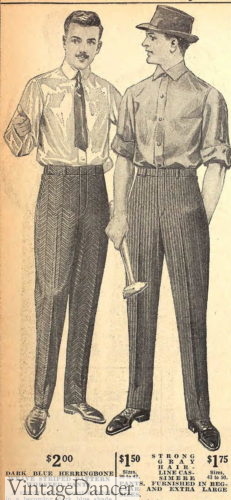
1915 men’s casual outfits for middle and lower classes
Need help with your outfit? Please contact us anytime.
Debbie Sessions has been teaching fashion history and helping people dress for vintage themed events since 2009. She has turned a hobby into VintageDancer.com with hundreds of well researched articles and hand picked links to vintage inspired clothing online. She aims to make dressing accurately (or not) an affordable option for all. Oh, and she dances too.
